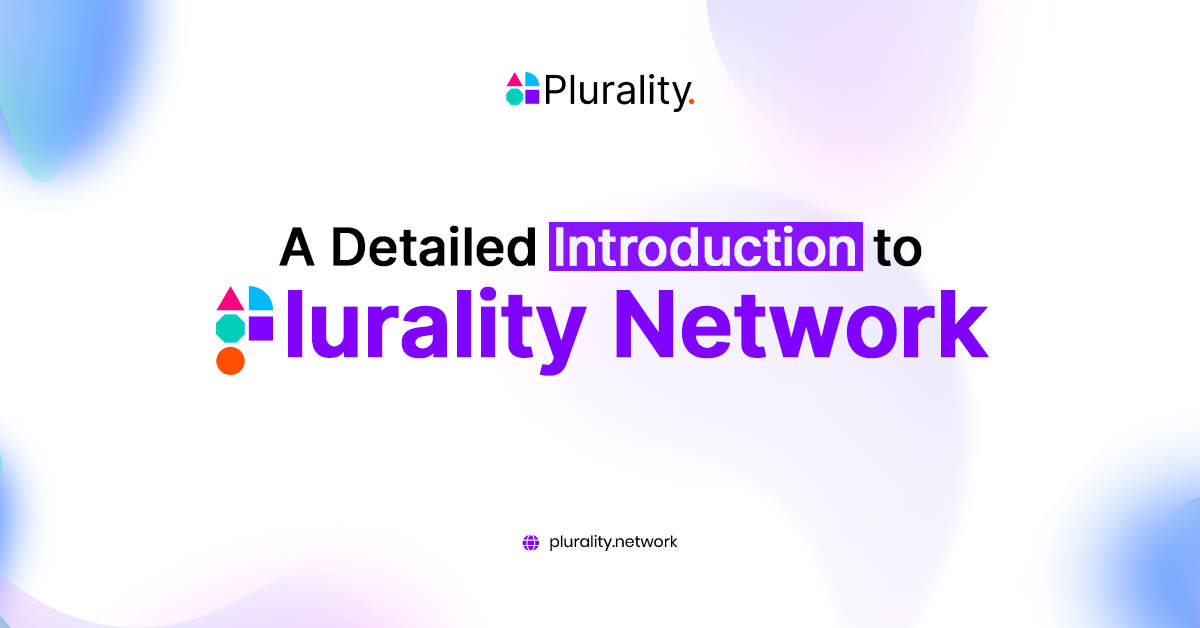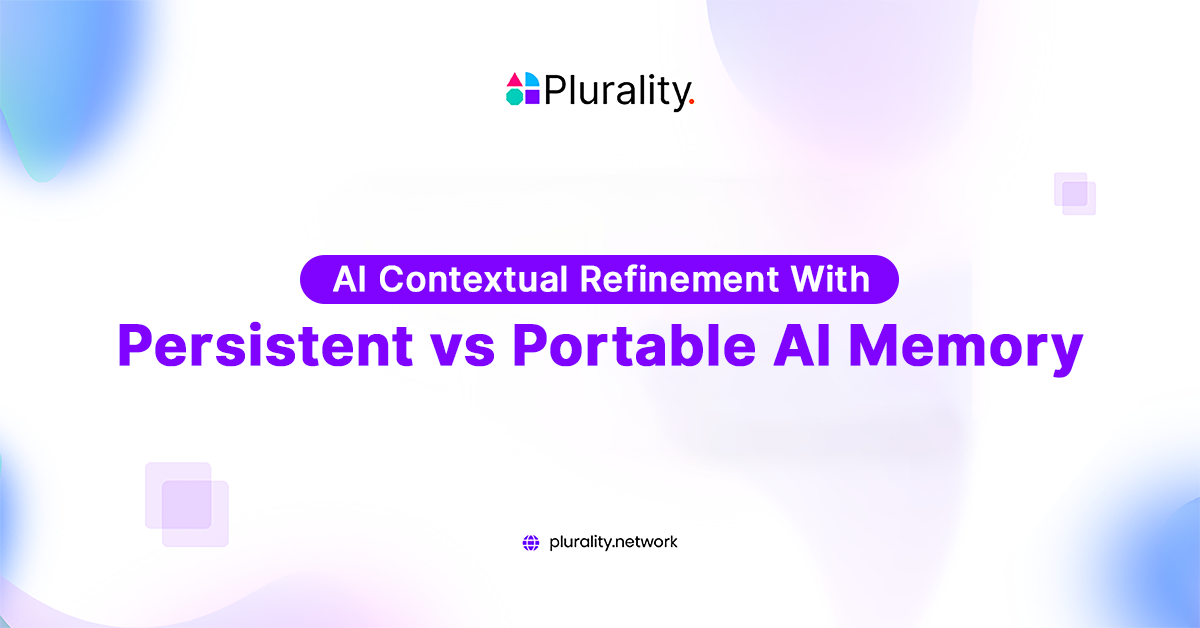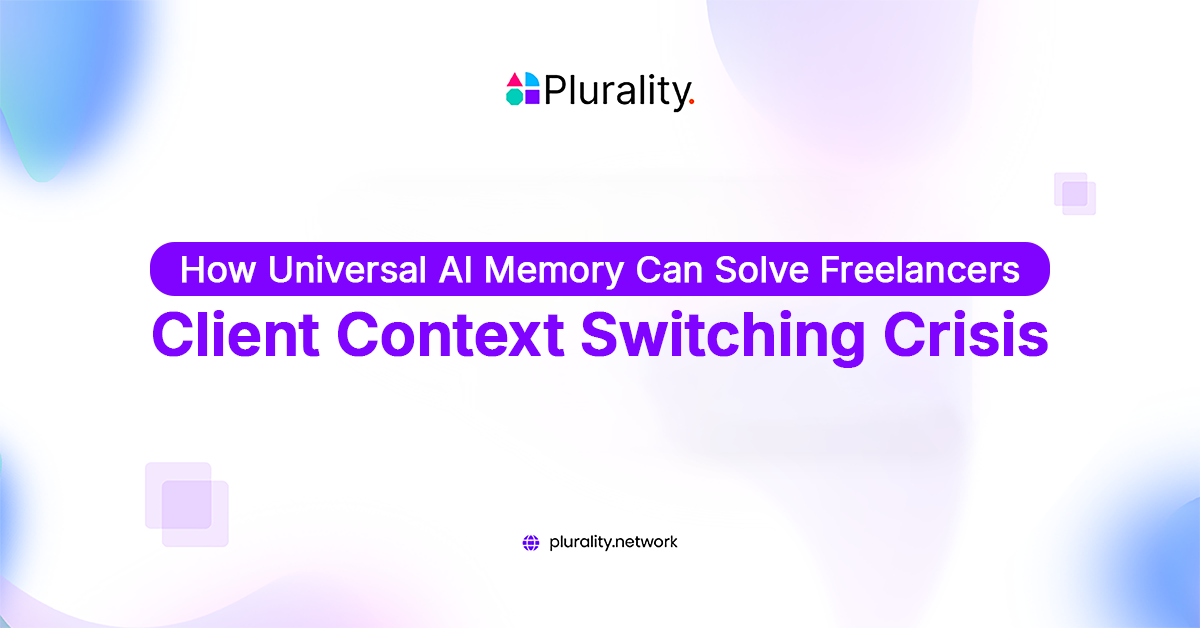A Detailed Introduction to Plurality Network
By Alev • December 30, 2024

An average user spends around 7 hours per day online on seven different platforms. On each platform, they engage in various interactions, leaving behind fragments of their personalities online, also known as the digital footprint or the user’s context.
These contexts are confined to the platforms on which they were created and controlled by centralized entities, who can use them as they see fit.
Plurality is creating the first open social context layer for the internet and, in doing so, is redefining the way we think about contexts and profiles. Atop the context layer, Plurality lets users create interoperable, self-custodial profiles (also known as the smart profiles) that are pluggable into any app across any platform.
By logging in through a specific profile, users allow the app to access that particular profile and receive tailor-made experiences according to their interests and preferences.
Plurality helps apps reduce cold starts, elevate engagement, boost retention, and create lasting connections by harnessing the power of profiles built atop open social context.
Going Deeper: Why Profiles Matter?
Profiles have evolved along with the internet. Let’s explore how the internet and profiles have evolved to understand Plurality’s innovation.

Web 1.0
When the internet was created, it was read-only, static, and context-less. It was a one-way communication channel without any concept of a profile. Yahoo exemplifies this era when people could read news and enjoy entertainment. This is known as the first generation or Web 1.0.
Web 2.0
As the internet evolved, platforms emerged where people could read information and interact with and create content. This was the era of social platforms, known as Web 2.0. Interactions became contextual, and the concept of profiles was introduced to achieve three key functionalities:

Identify
Profiles identify users within a platform, representing specific personas such as work, social, and gaming.
Contextualize
Profiles contextualize interactions. For example, if two accounts represent opposing opinions, the opinion of the one with more followers is often considered more credible.
Personalize
Profiles hold user interests and preferences, enabling platforms to personalize user experiences through functionalities like feed curation and recommendations. This helps platforms retain users and encourage them to return.
Profiles & Siloed Contexts
However, the contexts in profiles are siloed within platforms, making it a competitive business advantage. New platforms face the cold start problem as users must create their context from scratch.
This is why existing platforms with massive contexts have become dominant and challenging to compete with.
Web 3.0 and Plurality’s Smart Profiles
Web 3.0 introduces the ownership economy, allowing users to own content. Despite its potential, Web 3.0 platforms need help with cold starts and low retention rates, often relying on gamification to retain users. There’s still no way to own one’s context, profile, or social graph, trapping social capital in walled gardens.
Plurality creates an open social context layer with interoperable contexts of wallet addresses. It offers self-custodial and interoperable profiles that allow users to create multiple profiles linked to their wallet addresses.
These profiles are pluggable across any dApp on any blockchain, enabling users to own their social context and use it as desired.
For example, a Web3 music dApp would request that a user connect their music profile, while a Web3 work platform would request their work profile.
Smart profiles aggregate context from existing Web2 profiles and Web3 activity, enhancing user experience and retention rates while upholding privacy and consent principles.
The Future of Interoperable Profiles in Web 3.0
A New Dawn for Digital Identity
Web3 represents a paradigm shift in how users interact with the internet, moving from centralized control to user ownership. Plurality’s innovation lies in its ability to integrate user contexts across multiple platforms, breaking down the silos that have traditionally confined digital identities.
This not only enhances user experiences but also opens up new possibilities for interaction and personalization.
Bridging the Gap: Web2 and Web3
Plurality’s smart profiles bridge the traditional web (Web2) and the decentralized web (Web3). By aggregating context from both Web2 profiles and Web3 activities, Plurality ensures that users can seamlessly transition between different digital environments.
This hybrid approach leverages the strengths of both worlds, providing users with familiarity with Web2’s personalization and the autonomy of Web3’s ownership.
Enhancing User Experience with Smart Profiles
Personalized Interactions
Smart profiles enable apps to deliver highly personalized experiences when users log in. By understanding user preferences and behaviors, apps can tailor content, recommendations, and services to meet individual needs, significantly enhancing user satisfaction and engagement.
Reducing Cold Start Problems
One of the biggest challenges new platforms face is the cold start problem, with insufficient user data to provide meaningful interactions. Plurality’s interoperable profiles solve this by allowing new platforms to access pre-existing user contexts, jumpstarting engagement and retention from day one.
Boosting Retention and Engagement
Access to rich, cross-platform user contexts allows apps to create more engaging and relevant experiences. This leads to higher retention rates as users find value in the personalized content and services, encouraging them to return and interact more frequently.
The Ethical Dimension: Privacy and Consent
Plurality strongly emphasizes user privacy and consent. Plurality’s self-custodial profiles ensure that users have complete control over their data in an age of rampant data breaches and misuse.
Users can choose what information to share and with whom, making informed decisions about their digital footprint. This approach protects user privacy and builds trust in digital interactions.
Building a Collaborative Ecosystem
Network Effects
By fostering interoperability, Plurality encourages platforms to work together rather than compete. This collaborative ecosystem amplifies network effects, where the value of services increases as more users and platforms participate.
It creates a win-win scenario where success is shared, driving innovation and growth.
Open Data and Standards
Plurality advocates for open data and standards, ensuring no single entity can control user contexts. This democratizes digital identity, allowing users to move freely and use their data across various platforms without being locked into any one service provider.
The Road Ahead: Scaling and Adoption
As Web3 technologies mature, scalable and user-friendly solutions become paramount. Plurality is at the forefront of this evolution, continuously improving its smart profiles and context layer to handle the growing demands of a decentralized internet.
By focusing on scalability and ease of use, Plurality aims to drive mass adoption and make Web3 accessible to everyone.
Conclusion
Plurality is redefining digital identity and personalization in the age of Web3. Creating interoperable, self-custodial profiles enhances user experiences and empowers individuals with ownership and control over their digital lives.
As the internet continues to evolve, Plurality’s innovative approach is set to play a crucial role in shaping the future of online interactions, making the digital world more interconnected, personalized, and user-centric.



